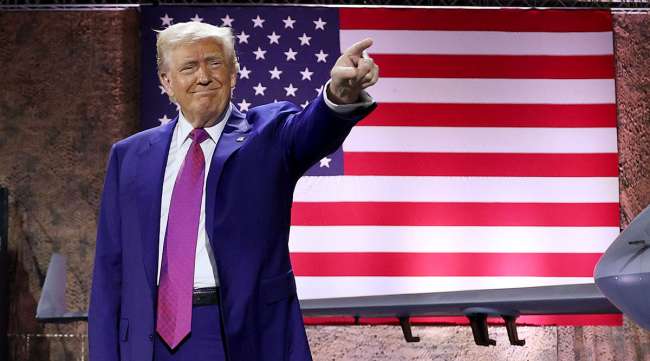Donald Trump by Win McNamee/Getty Images
The nonpartisan Congressional Budget Office handed Republicans a major political talking point June 4, with projections that showed the possibility for President Donald Trump’s tariffs to bring in more federal revenue than would be lost by his giant tax cut plan.
One notable caveat: The CBO assessment assumes that tariffs remain at very high levels for the next decade — something administration officials have not explicitly said is their intention. Treasury Secretary Scott Bessent has said that Trump “uses tariffs to negotiate.”
The two highly tentative CBO estimates show Trump’s tariffs, as of levels in effect in mid-May, shrinking the budget gap by $2.8 trillion over a decade, whereas the tax bill would add only $2.4 trillion to the gap. Those figures may feature in Republican arguments as they seek to assuage bond investors concerned about the U.S. borrowing trajectory and to convince fiscal hawks in their own party to back the legislation.

Bessent
The math isn’t simple, however. The CBO’s scoring of the “One Big Beautiful Bill” doesn’t account for dynamic impacts — in other words, how it may affect variables such as growth and interest rates, which could ultimately drive the expected cost higher or lower. But the estimates on how much revenue the tariffs could create does take into account the dynamic impacts.
Adding to the uncertainty, House Republicans narrowly passed the bill last month, and it now faces opposition in the Senate, where multiple lawmakers have expressed varying demands for changes.
The tax bill’s assessment reflects a $3.67 trillion decrease in expected revenue and a $1.25 trillion decline in spending over the decade through 2034, relative to baseline CBO projections.
Tariff Levels

Musk
Worries over the U.S. fiscal trajectory, with the debt-to-GDP ratio forecast to reach a record high in coming years, have stoked concerns about the tax bill among GOP fiscal hawks. Trump ally Elon Musk on June 3 blasted the package, saying in a post on X that this “massive, outrageous, pork-filled Congressional spending bill is a disgusting abomination.”
But Trump and his economic team have argued that the U.S. will be collecting hundreds of billions of dollars a year from new, higher tariff levels. The CBO backed that up with its new estimates.
The CBO found that the tariff hikes Trump had put in place by May 13 would reduce budget deficits by $2.5 trillion over the decade through 2035, and — by lowering net federal borrowing — would shrink them by another $500 billion thanks to interest-cost savings. Incorporating an estimated hit to GDP growth, thanks in part to foreign trade retaliation, the CBO figured on a $2.8 trillion net deficit reduction.
CBO Director Phillip Swagel, cautioned, in a letter to top Senate Democrats that included the estimates, that the figures “are subject to significant uncertainty,” in part because the Trump administration could change how it conducts its tariff policies.
Trade Talks
“Moreover, because the United States has implemented no increases in tariffs of this size in many decades, there is little relevant empirical evidence on their effects,” Swagel said.
Among the new import duties in place as of May 13 was a 30% surtax on Chinese goods, a 25% levy on most automobiles and auto parts and a 25% tax on a range of goods from Canada and Mexico, the CBO said.
Jim Nebergall of Cummins discusses the fuel-agnostic engine that can adapt to multiple fuel types and cut emissions without sacrificing performance. Tune in above or by going to RoadSigns.ttnews.com.
Also included: a 25% tariff on steel and aluminum, which Trump this week doubled to 50%. Swagel said in his letter that developments after May 13 “are not reflected” in the analysis.
Trump’s economic team is in talks with many U.S. trading partners, and deals may end up reducing the import levies. The legality of many tariffs is also in question, after the U.S. Court of International Trade ruled against the administration on May 28. A day later, a federal appeals court offered Trump a temporary reprieve from the ruling while weighing a longer-lasting hold. The White House has said it wants the Supreme Court to review the case.
Debt Limit
Besides added revenue from tariffs, Bessent and other Trump officials have argued that U.S. deficits will shrink thanks to positive effects on economic growth from tax cuts and deregulation.
Bessent has called on lawmakers to pass the bill, which includes an increase in the statutory debt limit, by mid-July. The Treasury has been using special accounting maneuvers to keep within the debt ceiling since the start of the year and has warned it could exhaust its capacity in August.
Fiscal conservatives have demanded the measure do more for deficit reduction. But other GOP members have demanded that temporary tax cuts in the bill be made permanent — which would further dampen revenues. The CBO score will also be reviewed by the Senate’s rules-keeper, who could determine whether provisions comply with the chamber’s requirements.
RELATED: House Backs Electric Vehicle, Hybrid Fees in Budget Bill
The bill encompasses much of Trump’s economic agenda. It would make permanent his 2017 income tax cuts and provide new benefits promised on the campaign trail — including eliminating taxes on tips and overtime pay through 2028. It also raises the cap on the federal deduction for state and local taxes to $40,000 from $10,000.
The bill has various federal spending cuts, including to clean-energy credits, and features new work requirements for Medicaid beneficiaries and new guidelines for the Supplemental Nutrition Assistance Program. Some of those cuts also face opposition among Senate Republicans.
The CBO release indicated that measures in the existing bill could leave 10.9 million people without health insurance in 2034. That includes 1.4 million without verified citizenship, nationality or satisfactory immigration status who would no longer be covered in state-only funded programs.







